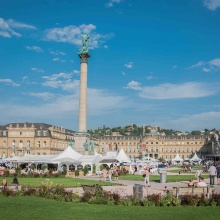Where does the name "Stuttgart" come from? When was the "Wasen" held for the first time and when was the University of Stuttgart founded? It is worth taking a brief look at Stuttgart's history.
Stuttgart, originally a 10th-century stud farm, is now the beautiful city located in the southwestern Germany at the locust of Neckar River. It is the centre of the largest industrial zone and holds various trade fairs and congresses. The metropolitan area is the site of the world or German headquarters for a number of prominent companies, including Mercedes and Porsche. Despite the auto industry at the heart of the local manufacturing sector, this region is also a home to many general and electrical engineering companies engaged in clean energy, robotics, and fuel cell and laser technology.
Earliest history
The earliest history of the Stuttgart town dates back to Roman times and its decline which led it to fall under the rule of the Franks and the Carolingians. The city was no where existed until 10th century when Duke Herzog Liudolf von Schwaben started a stud farm in an area of the Nesenbach Valley in 950 AD that was known as Stutengarten. The era for its transition from a stud farm to a medieval town and then to the status of a city began in 13th century followed by which the city became the official residence of the Count of Wurttemberg. By the 15th century, Stuttgart was officially declared as the capital city of the area Wurttemberg finally entering into the span of prosperity. However , the peace didn’t seem to prevail any longer and by the end of 16th century, the city followed a decline during the Thirty Years’ War (1618–48) and the French invasions of Louis XIV (1681–84) from which it did not recover any sooner.
Industrial Revolution
Until the Industrial Revolution in the 19th century when it became the capital of the Kingdom of Wurttemberg in 1805, Stuttgart seems to roll back in its skin of progress. In 1818, King Wilhelm I inaugurated an annual celebration of the city's survival in the face of that adversity and plague in past, which came to be known as the Cannstatter Volksfest - still held today. With the beginning of 19th century, the opportunity to change the course of the city's history once and for all brought in the railway with industrialization. Bosch's invention of the spark plug and Daimler's development of the petrol engine were significant factors in the evolution of the city's economy, not to forget, Gottlieb Daimler invented the car in his local Cannstatt workshop.
Inception of Academic Reforms
The city, in today’s age, encompasses technological colleges, a number of prestigious research centres, and academies for art, music, and architecture. Stuttgart is the seat of the University of Hohenheim which was founded 1818 whereas The University of Stuttgart was founded in 1829. It is now one of the leading technically oriented universities in Germany with global significance, carrying a vision of “Intelligent systems for a sustainable society”. Later towards the 21st century, in 1998, the Stuttgart Institute of Management and Technology was founded.
Post 19th Century
As soon as 19th century came to an end, the impending World War 1 finally broke down the Wurttemberg monarchy. Once the war was over, Stuttgart Central Station was rebuilt while the Stuttgart Observatory became active. Rotenberg and Zuffenhausen – the borough towns- became part of city whereby Ferdinand Porsche was pretty in business. With the year 1939 ending, Stuttgart Airport was built to replace Böblingen Airport, and deportation of Jews began. World War II had already invaded the grounds and during the same time, RBK- Robert Bosch hospital was also founded hence aided during the consecutive years of aerial bombing until the end of Second World War in 1945. Following the same year, the United States Army took over the airport until returning it to German authorities in 1948.
Most of Stuttgart's buildings were destroyed during Allied air raids and the old part of the city was particularly badly damaged during a raid that took place in September 1944.
Many of the city's historic buildings have survived to this day as a result of post-war planning, and numerous large parks have also been preserved. Although it was hoped that Stuttgart would become the capital of the newly formed Federal Republic of Germany, this was not to be. Instead, it has served as the seat of government for the new state of Baden-Wurttemberg since 1952.
Stuttgart now has a population of around 600,000 people, making it the sixth-largest city in Germany.
Muhammad
Comments
- Noor
-
January 7, 2025 1:45 PM
Hoi,
Deze informatie was heel nuttig voor mijn Duits mondeling over Stuttgart! Bedankt!
Met vriendelijke groet,
Noor
Comment on this article
Your email address will not be published.



